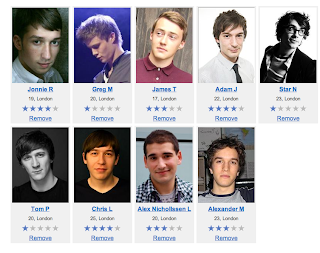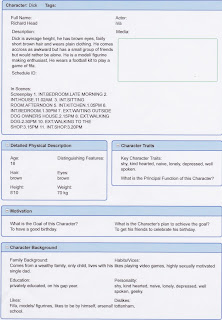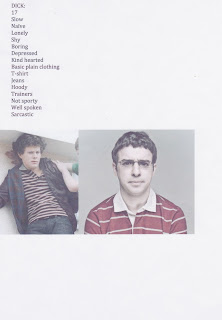Tuesday, 23 November 2010
THE INBETWEENERS
Here is a selection of scenes from the inbetweeners, we hope to recreate these types of situation in our film.
AMERICAN PIE WRITERS - TEEN SEX COMEDY CLICHES
Thursday, 18 November 2010
Tuesday, 16 November 2010
PRE-PRODUCTION
We have been given a booth in the media classroom to put all of our research and planning up to help with the organisation of our pre-production.
Monday, 1 November 2010
SOUND AND MUSIC
DICK MOOD BOARD




SALLY MOOD BOARD
SCENE BREAKDOWN
SCRIPT, FIRST DRAFT
RESEARCH
ROLES
- Producer
- Camera
- Editing
- Music
- Scheduling
- Casting
- Director
- Costume
- Location
- Title Sequence
- Camera
- Sound
- Location
- Props
- Casting
- Set Design
- Editing
- Sound
- Sound FX
- Location
- Casting
- Make-up
- Costume
PRODUCTION MEETING
SCENE LIST, SECOND DRAFT
Monday, 11 October 2010
SCENE LIST, FIRST DRAFT
Sunday, 3 October 2010
AN IDEA FOR OUR FILM
Monday, 27 September 2010
SHORT STORY #3
His Story
SHORT STORY #2
SHORT STORY #1
Monday, 20 September 2010
LUCKY (short film by Nash Edgerton)
BITCH (short film by Dom Bridges)
LOVEFIELD (short film by Mathieu Ratthe)
DOGME 95
- Filming must be done on location. Props and sets must not be brought in. If a particular prop is necessary for the story, a location must be chosen where this prop is to be found.
- The sound must never be produced apart from the images or vice versa. Music must not be used unless it occurs within the scene being filmed, i.e., diegetic.
- The camera must be a hand-held camera. Any movement or immobility attainable in the hand is permitted. The film must not take place where the camera is standing; filming must take place where the action takes place.
- The film must be in colour. Special lighting is not acceptable (if there is too little light for exposure the scene must be cut or a single lamp be attached to the camera).
- Optical work and filters are forbidden.
- The film must not contain superficial action (murders, weapons, etc. must not occur.)
- Temporal and geographical alienation are forbidden (that is to say that the film takes place here and now).
- Genre movies are not acceptable.
- The final picture must be transferred to the Academy 35mm film, with an aspect ratio of 4:3, that is, not widescreen. (Originally, the requirement was that the film had to be filmed on Academy 35mm film, but the rule was relaxed to allow low-budget productions.)
- The director must not be credited.
MY FAVOURITE DIRECTORS
FRENCH NEW WAVE
Thursday, 16 September 2010
FILM NOIR
Film Noir or black film is a cinematic term used primarily to describe stylish hollywood crime dramas, particularly those that emphasize cynical attitudes and sexual motivations. Hollywood's classic film noir period is generally regarded as stretching from the early 1940s to the late 1950s. Film noir of this era is associated with a low-key black and white visual style that has roots in german expressionist cinematography. The term was widely adopted in the 1970s, many of the classic film noirs were referred to as melodramas. The question of whether film noir qualifies as a distinct genre is a matter of ongoing debate.
Monday, 13 September 2010
AVANT-GARDE FILM
CINÉMA VÉRITÉ
Sunday, 12 September 2010
THE BRIEF
The OCR brief asks you to produce a short film and two from these three:
- Poster.
- Radio Trailer.
- Film magazine review page.


























